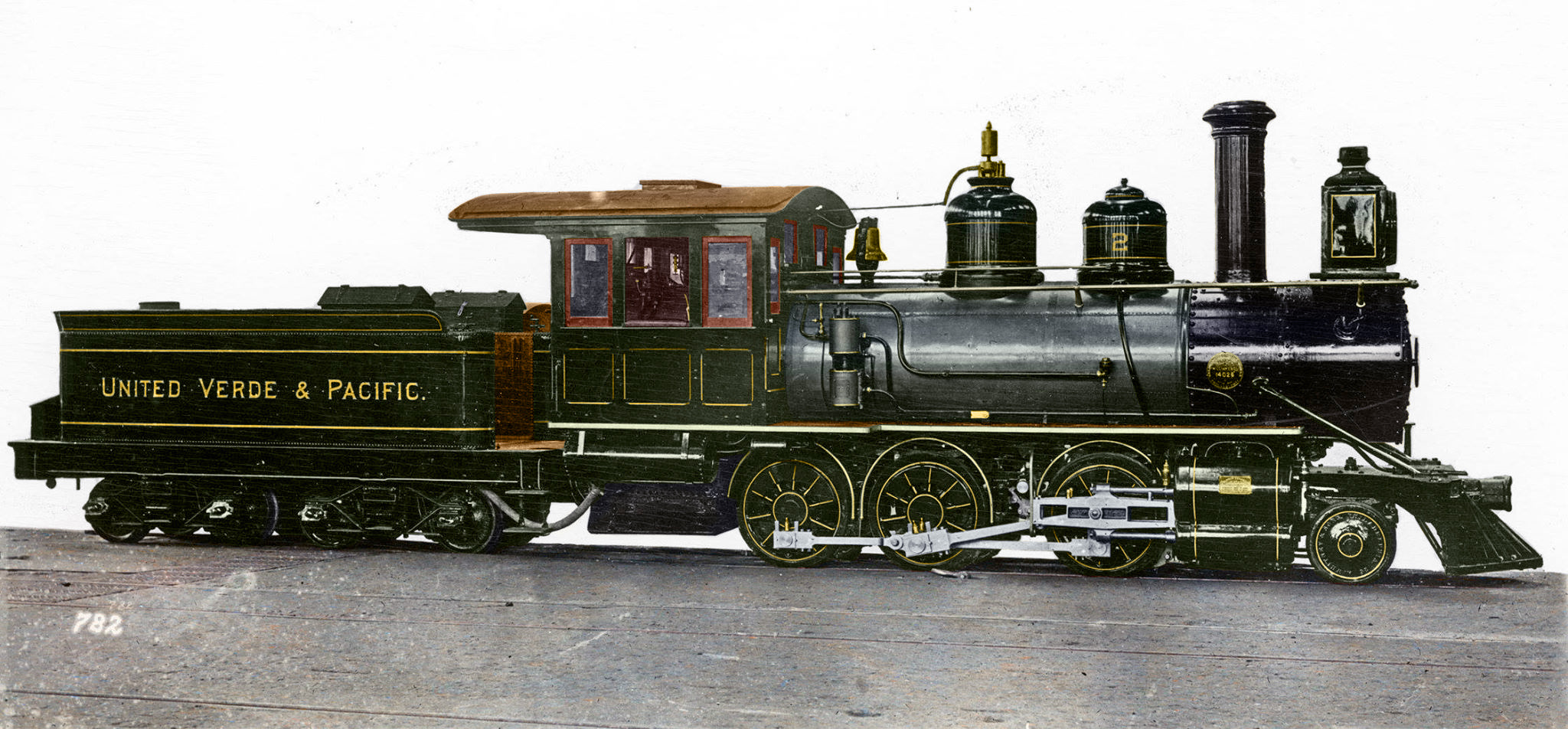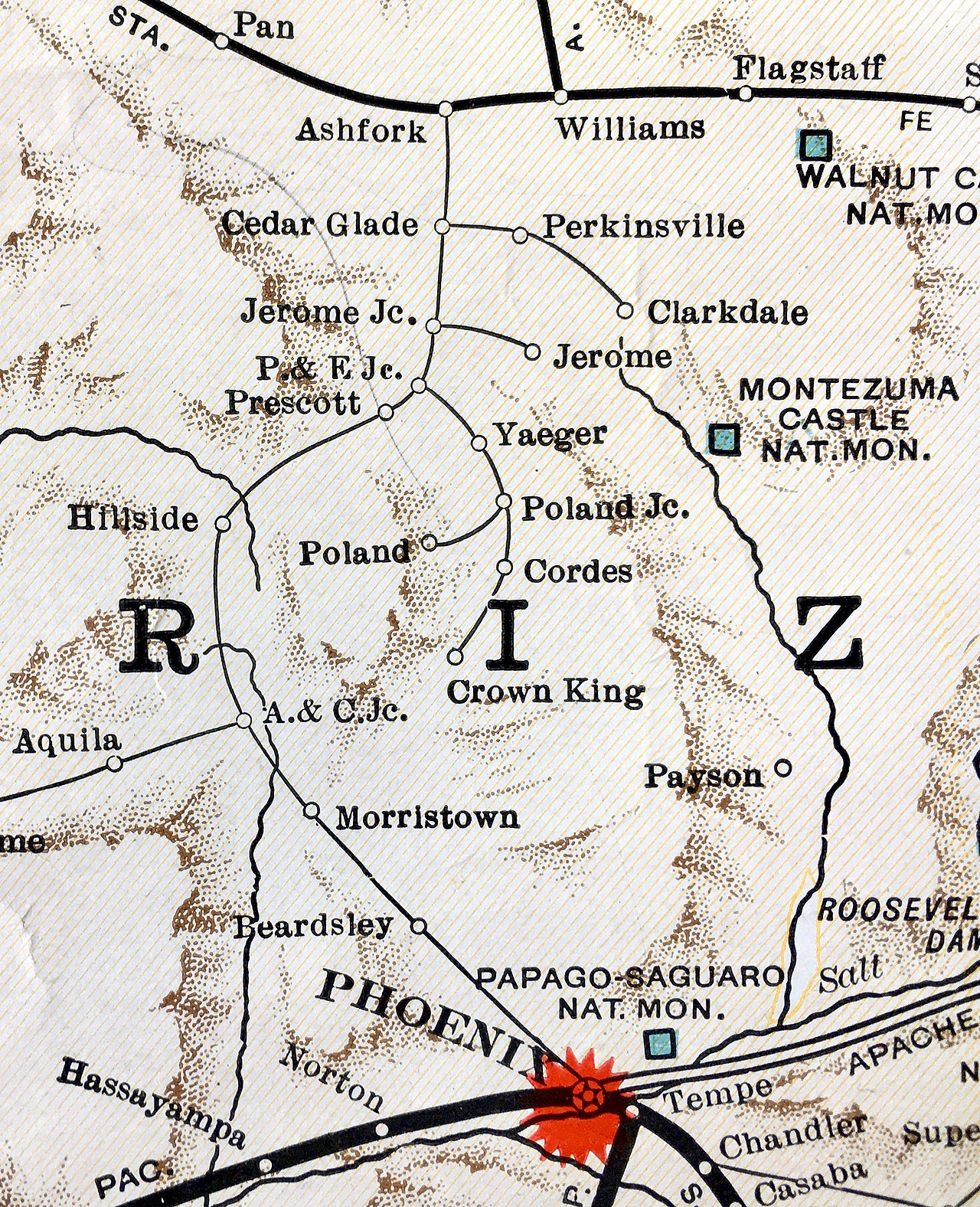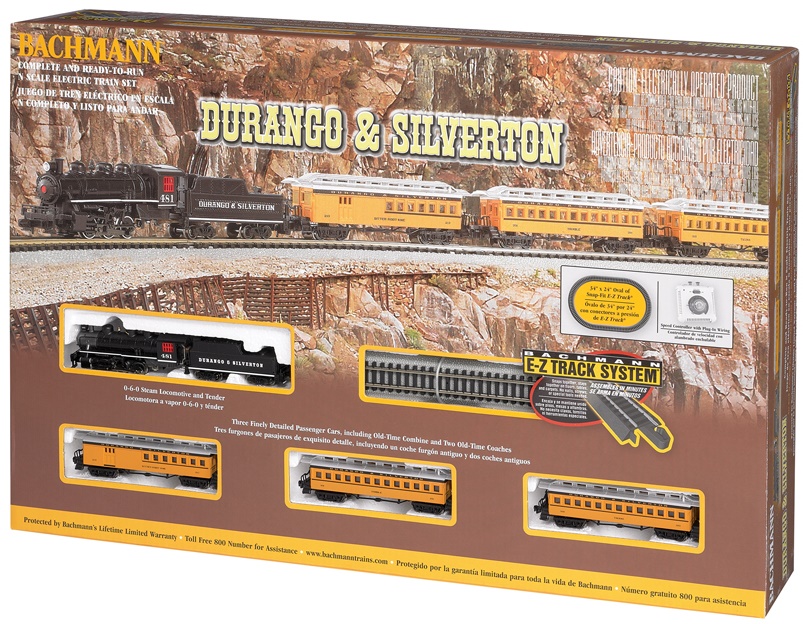Company History: The United Verde and Pacific Railway was a 3 ft (914 mm) narrow gauge railroad that operated from 1895 to 1920 in what became Yavapai County in the U.S. state of Arizona. William A. Clark built the 26-mile (42 km) line to link his copper mine and smelter in Jerome to an existing branch of the Santa Fe Railway system. Clark eventually replaced the line with three 4 ft 8+1⁄2 in (1,435 mm) standard gauge rail lines after building a new smelter and company town in Clarkdale.
Early owners of the United Verde copper mine in Jerome relied on mule-drawn wagons to transport material to and from the mine. In 1882, the Atlantic and Pacific Railroad (A&P) had completed a railway line across northern Arizona, and a north–south 60-mile (97 km) wagon road was built between Jerome and Ash Fork, where it met the railroad. By 1886, an investor, Thomas S. Bullock, had built another line, the Prescott and Arizona Central (P&AC), from Seligman on the A&P line south to Prescott. Eugene Jerome—for whom Jerome is named—and the other owners of the United Verde mine switched to shipping about 30 miles (48 km) west to the P&AC, still by wagon. This arrangement briefly succeeded, but in 1887 the United Verde mine closed after the price of copper fell, and Bullock's line faced serious problems with debt, mismanagement, and failing infrastructure. In 1892, Santa Fe Railway interests built a branch line from Ash Fork to Prescott and forced Bullock's P&AC line out of business. The new line, the Santa Fe, Prescott and Phoenix Railway (SFP&P), was financially sound and well-managed.
William Andrews Clark, a wealthy Montana businessman and later a U.S. Senator, acquired a controlling share in the United Verde mine in 1888. Aware of the mine's potential and of the increasing demand for copper for use in electrical distribution systems, Clark decided to connect his mine by rail to the SFP&P. He paid out of his own fortune the entire $600,000 it took to complete the United Verde & Pacific Railway. The line was finished in 1894, and scheduled service began in 1895.
Unquenchable fires that began in the United Verde mine in 1894 eventually led Clark to convert operations in Jerome to open-pit mining. To accomplish this, Clark had to move the smelter complex, which had been built directly above the mine. In a series of projects beginning in 1911, Clark moved the surface plant in Jerome; built a smelter and company town, Clarkdale, in the Verde Valley below Jerome; and financed construction of three new standard gauge railroads—the Verde Tunnel and Smelter line and the Hopewell Haulage Tunnel to carry ore to Clarkdale, and the Verde Valley Railroad, to link Clarkdale to the Santa Fe Railway system at Drake. By 1919, the Verde Tunnel and Smelter line was extended to Jerome, and the United Verde & Pacific became completely obsolete. Its last train left the station in May 1920.From Wikipedia
Early owners of the United Verde copper mine in Jerome relied on mule-drawn wagons to transport material to and from the mine. In 1882, the Atlantic and Pacific Railroad (A&P) had completed a railway line across northern Arizona, and a north–south 60-mile (97 km) wagon road was built between Jerome and Ash Fork, where it met the railroad. By 1886, an investor, Thomas S. Bullock, had built another line, the Prescott and Arizona Central (P&AC), from Seligman on the A&P line south to Prescott. Eugene Jerome—for whom Jerome is named—and the other owners of the United Verde mine switched to shipping about 30 miles (48 km) west to the P&AC, still by wagon. This arrangement briefly succeeded, but in 1887 the United Verde mine closed after the price of copper fell, and Bullock's line faced serious problems with debt, mismanagement, and failing infrastructure. In 1892, Santa Fe Railway interests built a branch line from Ash Fork to Prescott and forced Bullock's P&AC line out of business. The new line, the Santa Fe, Prescott and Phoenix Railway (SFP&P), was financially sound and well-managed.
William Andrews Clark, a wealthy Montana businessman and later a U.S. Senator, acquired a controlling share in the United Verde mine in 1888. Aware of the mine's potential and of the increasing demand for copper for use in electrical distribution systems, Clark decided to connect his mine by rail to the SFP&P. He paid out of his own fortune the entire $600,000 it took to complete the United Verde & Pacific Railway. The line was finished in 1894, and scheduled service began in 1895.
Unquenchable fires that began in the United Verde mine in 1894 eventually led Clark to convert operations in Jerome to open-pit mining. To accomplish this, Clark had to move the smelter complex, which had been built directly above the mine. In a series of projects beginning in 1911, Clark moved the surface plant in Jerome; built a smelter and company town, Clarkdale, in the Verde Valley below Jerome; and financed construction of three new standard gauge railroads—the Verde Tunnel and Smelter line and the Hopewell Haulage Tunnel to carry ore to Clarkdale, and the Verde Valley Railroad, to link Clarkdale to the Santa Fe Railway system at Drake. By 1919, the Verde Tunnel and Smelter line was extended to Jerome, and the United Verde & Pacific became completely obsolete. Its last train left the station in May 1920.From Wikipedia
Brief History: The U.S. is a country of 50 states covering a vast swath of North America, with Alaska in the northwest and Hawaii extending the nation’s presence into the Pacific Ocean. Major Atlantic Coast cities are New York, a global finance and culture center, and capital Washington, DC. Midwestern metropolis Chicago is known for influential architecture and on the west coast, Los Angeles' Hollywood is famed for filmmaking.
Item created by: CNW400 on 2022-02-01 17:54:47
If you see errors or missing data in this entry, please feel free to log in and edit it. Anyone with a Gmail account can log in instantly.
If you see errors or missing data in this entry, please feel free to log in and edit it. Anyone with a Gmail account can log in instantly.









